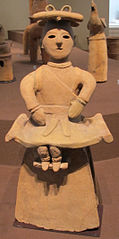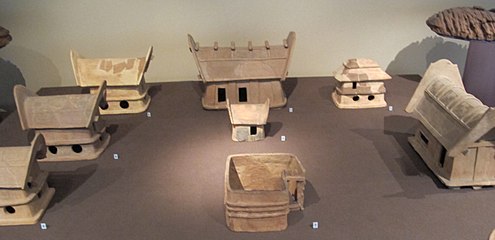Haniwa


TheHaniwa(Đất sét luân)areterracottaclay[2][3]figures that were made for ritual use and buried with the dead as funerary objects during theKofun period(3rd to 6th centuries AD) of thehistory of Japan.Haniwawere created according to thewazumitechnique, in which mounds of coiled clay were built up to shape the figure, layer by layer.[4]Haniwacan also refer to offering cylinders, not the clay sculptures on top of them[5]as well as the "wooden haniwa" found inKofuntumuli.[6]
TerracottaHaniwawere made with water-based clay and dried into a coarse and absorbent material that stood the test of time. Their name means "circle of clay", referring to how they were arranged in a circle above the tomb. The protruding parts of the figures were made separately and then attached, while a few things were carved into them. They were smoothed out by a wooden paddle. Terraces were arranged to place them with a cylindrical base into the ground, where the earth would hold them in place.
During the Kofun period, a highly aristocratic society with militaristic rulers developed. Thecavalrywore iron armor, carriedswordsand other weapons, and used advanced military methods like those of northeast Asia. Many of them are represented inhaniwafigurines for funerary purposes.
The most important of thehaniwawere found in southernHonshū—especially theKinairegion aroundNara—and northernKyūshū.Haniwagrave offerings were made in many forms, such as horses, chickens, birds, fans, fish, houses, weapons, shields, sunshades, pillows, and humans. Besides decorative and spiritual reasons of protecting the deceased in the afterlife, these figures served as a sort of retaining wall for theburial mound.
Because thesehaniwadisplay the contemporary clothing, hairstyle, farming tools, and architecture, these sculptures are important as a historical archive of the Kofun Period.
Everyday pottery items from that period are calledHaji pottery.
History[edit]
Origin[edit]
Earlier, clay figurines, calleddogū,appeared during theJōmon period.
Hiroaki Satocites a passage from theNihon Shoki,in whichEmperor Suininissued an imperial edict concerning funerals: "From now on make it a rule to erect clay figures and not to hurt people." It was therefore thought that these clay figures may have replaced live human sacrifices.[7]However,haniwafigures were not made until long after Suinin's rule had ended.[8]
The origin ofhaniwastarted during the latter part of theYayoi periodaround theKingdom of Kibi.During this time special earthenware figurines and bowls started to appear on top of the tombs of leaders. The early sculptures exceeded 1 m (3.3 ft) in length. They consisted of a cylindrical portion, which represented the torso, and a skirt-shaped portion at the base, which represented the legs. Many times a special insignia or pattern would be displayed on the torso. Sometimes an obi would be placed around the torso. These sculptures are thought to have been used as part of a funeral ritual. Other than the Kibi area, the only other place these sculptures were found was in theIzumo province.
During the latter part of the third century, these sculptures started to appear on top of the imperialgrave moundsin the Kinai region. During this time more elaboratehaniwaappeared with earthenware bowls. It is believed that the movement of these sculptures andhaniwafrom the Kibi region to the Kinai region is indicative of an increase in their importance.
Later developments[edit]
During the earlier part of theKofun period(later 3rd century CE) the only earthenwarehaniwawere cylindrical, like barrels. These haniwa barrels were used to form thekofunmound. They were arranged in the shape of the mound (square, circle, or keyhole) and soil was brought in to fill the interior, and then a new row of haniwa barrels was arranged to make the next level and the process was repeated until the mound was the desired height. Additional soil was added to the exterior to form sloping sides.
Toward the early 4th century CE,haniwasculptures in the shape of shields and other tools started to appear. By the middleKofun period(mid-5th century AD), there werehaniwastatues in the shape ofshrine maidens,horses, dogs, and other animals. As the practice of ceremonialburial moundsdeclined in the mid-6th century CE,haniwabecame rarer in the Kinai region; however,haniwawere made in abundance in theKantō region.
It is not uncommon for some haniwa to be painted with red dye or other colors. Besides the cylindrical haniwa (enkei-haniwa), another common type was the house-shaped haniwa (keisho-haniwa). Other things that fell into the category of keisho-haniwa were those shaped like humans, animals, and swords. The details on the haniwa give information about the elite buried in the tomb, and represent some of the tools or other objects people of that time used. The military haniwa inform archeologists of the armour and weapons, as well as the status symbols of the military class.
-
Seated woman
-
Haniwahouses
Significance[edit]
Originally, the cylindrical typehaniwawere set on top of thefuneral mounds,so it is believed that they had a purpose in funeral rituals; however, as thehaniwabecame more developed, they were set toward the outside of the grave area. It is thought that they were used as boundary markers for the borders of the gravesite.
There is a theory that the soul of the deceased would reside in thehaniwa,as the earlierhaniwawere placed on top of the funeral mounds. There arehaniwathat are equipped with weapons and armor. These are thought to be containers for souls. The armor and weapons would drive away evil spirits and protect the buried ruler from calamity.[citation needed]Because the horse- and animal-shapedhaniwawere normally neatly arranged into a line, it is believed that they were part of a sending-off ceremony.
In modern society[edit]

Although the religious implications of thehaniwahave largely declined in modern society, the sculptures are prized by many for their aesthetic and historical significance. The works of Isamu Noguchi, for example, were heavily influenced by thehaniwa.[9][10]They have been accepted as "Pure Art", according toTimemagazine.[11]Beyond simple appreciation as artistic sculptures, modern popular culture has, in some cases, portrayed thehaniwaas containing a sentient entity and not just as a simple empty sculpture.
The portrayal of livinghaniwahas—since the late 1990s—become widespread, being featured in entertainment mediums, including but not limited to:video games,trading cards,movies,andtelevision.In some of the depictions, thehaniwais primarily presented as a ghostlike, malevolent creature with noemotional remorseto complete its task. The most common portrayal depicts thehaniwawith a rounded, pot-like shape, bearing two deep eyes, a wide mouth, and two featureless "arms" on opposite sides of the "pot". Gyroids in theAnimal Crossingvideo game series are based on Haniwa.
See also[edit]
- Ancient Egyptian funerary practices
- Cult image,also known as an idol
- Dogū
- Haniwa Terracotta Dancers
- Hōko (doll)
- Mozu Tombs
- Terracotta Army,of ancient China
- Ushabti,ancient Egyptian burial sculpture
- Zuijin
References[edit]
- ^Đất sét luân phục viên の võ nhânArchived2012-10-11 at theWayback Machine(in Japanese)
- ^Evans, Toshie M. (1997).A Dictionary of Japanese Loanwords.Greenwood Publishing Group. p. 50.ISBN0-313-28741-4.Archivedfrom the original on 2016-04-25.Retrieved2015-10-18.Extract of page 50Archived2019-03-30 at theWayback Machine
- ^Kleiner, Fred (2009).Gardner's Art through the Ages: Non-Western Perspectives(13th ed.). Cengage Learning. p. 92.ISBN978-0-495-57367-8.Archivedfrom the original on 24 April 2016.Extract of page 92Archived2016-06-29 at theWayback Machine
- ^Nussbaum, Louis Frédéric(2002).Le Japon: Dictionnaire et Civilisation[Japan Encyclopedia]. Translated by Käthe Roth. United States of America: Harvard University Press Reference Library. pp. 286, 833.ISBN9780674017535.
- ^"Kofun Period (ca. 300–710)".The Met Museum.Retrieved15 January2023.
- ^"Archaeologists unearth largest wooden 'haniwa' statue ever found in Japan".9 December 2022.
- ^Sato, Hiroaki (1995).Legends of the Samurai.Overlook Duckworth. pp. 68–70.ISBN9781590207307.
- ^"Art: The Haniwa Rage".Time.21 July 1958. Archived fromthe originalon October 26, 2007.Retrieved4 October2017.
- ^Altshuler, Bruce (1996). "The Ceramic Sculpture of Isamu Noguchi". In Saison Museum; Bijutsukan Renraku Kyōgikai;Museum of Modern Art, Kamakura & Hayama;Fukuyama Museum of Art (eds.).Isamu Noguchi to Kitaōji Rosanjin [Isamu Noguchi, Rosanjin Kitaōji](in Japanese). Translated by Ogawa, Kikuko.Yomiuri Shimbun.OCLC35856363.
- ^Reprinted from an exhibition catalog for an art show toured to four museums in Japan in 1996.Altshuler, Bruce."The Ceramic Sculpture of Isamu Noguchi".Noguchi Museum.Archived fromthe originalon 2005-07-20.Retrieved2017-10-04.
- ^"Art: The Haniwa Rage".Time.21 July 1958. Archived fromthe originalon October 26, 2007.Retrieved4 October2017.
Further reading[edit]
- Park, T. (1988). Haniwa figure of a horse.Art Education,41(5), 25.
External links[edit]
![]() Media related toHaniwaat Wikimedia Commons
Media related toHaniwaat Wikimedia Commons
- ^Hsueh Shirai, Yoko."Haniwa warrior".Smarthistory.Archivedfrom the original on December 5, 2016.RetrievedDecember 2,2016.





